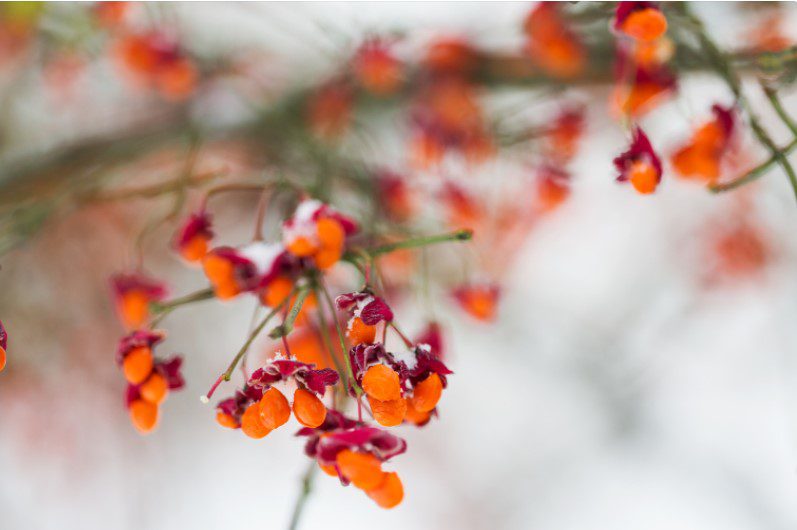Euonymus
When you seek a plant that will be a trouble-free workhorse in your landscape, you will do well to consider the group of plants known as Euonymus. This genus is represented by evergreen forms as well as the almost too-well-known burning bush deciduous Euonymus.
Need a ground-cover plant, a vine, a neat-growing or a broad-developing shrub?
There is a Euonymus that may be just right for you.
Seldom does one plant group offer the range in growth habits or foliage colors that you can obtain within this plant group?
Types Of Euonymus
Starting with a gem that would be appropriate in a rock garden, wall planting, or container garden, the Euonymus Kewensis, or the Kew Wintercreeper, is a low-growing ground cover or climber with tiny, dark green evergreen leaves.
Next up in size is Coloratus or the Purple-leaf Wintercreeper. This selection is a fast-developing ground cover with evergreen leaves an inch long that turn from green to a rich purplish-red in the fall and remain that color all winter long.
Then we have the evergreen forms with variegated foliage. Emerald Gaity has green leaves with pronounced white margins.
The plant forms a compact mound and grows to about 4 feet high and 2 feet wide—the cultivar Emerald ‘n’ Gold sports broad yellow margins on medium-sized green leaves.
Each type displays touches of pink color in the spring and fall. Both are apt to develop all-green shoots.
Moonshadow has bold yellow centers to its green leaves. Ivory Jade features white edges to green foliage on 3-foot-tall plants. Emerald Surprise, Canadale Gold, Sunrise, and Sun Spot vary on the theme of silver or gold variegated evergreen plants. There are several other larger-leafed, faster-growing, taller-climbing forms should you need them.
About Euonymus Shrubs
Before we leave the evergreen forms, several points should be made. While the all-green-leafed forms will do equally well in sun or shade, the silver and the green variegated-leafed forms display their best color in the sun. With nothing to climb on, this plant acts like any ground cover and spreads along the ground.
Euonymus vegetus will reach 20 feet or more up into trees. These plants attach themselves to brickwork, wood siding, and tree trunks using small, root-like holdfasts that function like suction cups to glue themselves to almost any surface.
They do not damage masonry, brick, or wood, nor do they require a trellis or other support to aid their ascent.
As with all broad-leafed evergreens, the foliage is fed upon by the black vine weevil. This destructive pest can be managed with the careful use of a soil pesticide. Scale is a pest that, left unchecked, will kill the plant.
The male scale insects are narrow and white. The females are brown and oval. Infections begin at the base of the plant and move upward and outward. The use of a summer oil spray can control infections that have not spread extensively.
A disease, Crown Gall, infects a variety of plants, including roses. If only a few swollen, warty galls are growing on the plant, an attempt to control by pruning the galls may be tried. However, the crown gall can kill a Euonymus almost as fast as it will kill a rosebush.
Euonymus alatus, or the Winged Burning Bush, grows in a rounded form up to 10 feet tall and covers itself with vivid scarlet-red fall foliage.
Euonymus americanus, Strawberry-bush, Euonymus europaeus Aldenhamensis, Spindle Tree, and other deciduous Euonymus shrubs await your discovery.
Euonymus Care Must-Knows
There are approximately 175 species within this family. This means that requirements will vary. However, the preferred soil conditions remain relatively consistent. Ideally, euonymus should only be planted in rich, well-drained, and medium-moisture soil.
Wet soil can lead to rotting and other problems. Euonymus can tolerate drought once established.
Different sun exposures are required for Euonymus varieties. Most of the larger shrub and tree types, particularly those with fall colors, need more sunlight.
Full sun is the best, but some varieties, such as variegated and low-growing types, can tolerate shade. To keep shrubby or low-growing varieties looking good, they will need to be trimmed.
The Euonymus scale is the most serious pest. These tiny insects are found on the undersides of the leaves and the stems of E. Fortunei types. Their pear-shaped bodies can identify the gray and white pests.
Infested plants should be removed immediately, particularly if they are heavily infested. To prevent further problems, you may need to use a systemic insecticide even after the plant has been removed.
Important to remember is that many euonymus species have become invasive in native forests, particularly burning bush and many E. Fortunei varieties.
These plants should not be planted unless it is declared invasive by the local authorities.


























